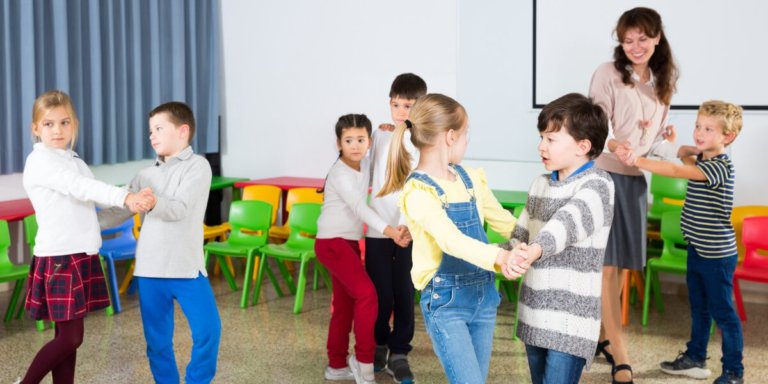
Many schools today are seeing the benefit of adopting classroom practices that help build social-emotional learning skills.
According to CASEL, “Social and emotional learning (SEL) is the process through which children and adults understand and manage emotions, set and achieve positive goals, feel and show empathy for others, establish and maintain positive relationships, and make responsible decisions.”
When developed from an early age, children with these skills grow up to become adults who can process their emotions positively and maintain healthy relationships.
So how can social-emotional learning skills be developed? There are several ways; from hugging each student every morning, to using vision boards where kids can express their feelings, to role-playing activities – the list goes on.
Encouraging them to express themselves physically, through dance, for example, also helps students develop social and emotional learning skills.
Margot Toppen, Founder and CEO of EduMotion, wrote on Edutopia, “The most successful social and emotional learning (SEL) programs use active forms of learning to teach students, and evidence suggests that dance outpaces other forms of physical activity and other forms of arts learning when it comes to improving SEL outcomes.”
While dancing is great for kids as they can get some exercise and relieve stress, there are also several benefits when it comes to social-emotional learning.
Exploring and expressing emotions
Fourth grade is having a blast learning the Russian folk dance ‘Sasha!’ Folk dancing is a great way to learn about other cultures and adds to students social, emotional, and physical well-being, making it an integral part of general music curriculum! 🎶 @POBMusicDept pic.twitter.com/HIQ7Qw6eC9
— Ms. Harrington (@eharringtonPOB) September 13, 2019
Being able to express our emotions is healthy, which is why psychologists recommend that people don’t make a habit of burying their feelings.
Being able to express yourself in an authentic way leads to closer personal connections and prevents you from closing yourself off and saying you’re fine when you’re really not.
Through dance, kids learn how to express their emotions and watch how their peers perform, which allows them to identify emotions in others so they can become more empathetic.
As an example for teachers, Toppen wrote, “Dance and movement can be a great way for students to explore how emotions are shown and felt in their bodies. Give your student this prompt: “Emotion is a word that describes the feelings you have. How does your face show emotion? How do other parts of your body show emotion?”
“Next, invite students to follow along to the dance or movement video you’ve selected. After the students perform the dance together, ask them to choose a favorite move from the dance and practice that move while showing an emotion they select. They can do this in pairs—each student should guess what emotion their partner is trying to convey. ”
At the end of the activity, Toppen advises teachers to ask students to reflect on how their body felt when they expressed a particular emotion.
“By thinking about what an emotion feels and looks like in their body, they become more self-aware and attuned to their emotions.”
Developing social emotional learning skills through body language
Mills Lawn is ready for a Day of Discovery! The 4th-6th graders kicked off their day of social and emotional learning this morning with a fun group dance. #FearlessThinkers pic.twitter.com/wayJl4cPvP
— YellowSpringsSchools (@YSpringsSchools) February 12, 2019
Another great way dance helps students develop social-emotional learning skills is by encouraging non-verbal communication.
Body language is a key trait of communication that’s often overlooked, but is a major part of building relationships and identifying emotions in others.
Being able to communicate non-verbally also helps when there are cultural and linguistic barriers. Dance activities help students express themselves through non-verbal communication as well as read body language in others.
Toppen suggests that teachers reflect on how they use body language through dance movements to communicate with their peers.
Then, they should have the students give each other feedback with active listening skills. “Have them try the dance or movement while facing a partner, and think about how they can be friendly with their partner as they work together.
“After trying some steps together, prompt them to talk to each other about how it went—was it easy? hard? fun? silly? While they’re listening to their partner’s feedback, they should make eye contact and smile in encouragement. Prompt them to end the activity by thanking each other and exchanging a handshake or high five.”
Dancing really is a great way for kids to let off some steam while developing their social-emotional learning emotional skills in an active and engaging way.
Liked this? Then you’ll love…
Can an app teach students social emotional skills?
How social and emotional learning can be taught through inspiring stories







